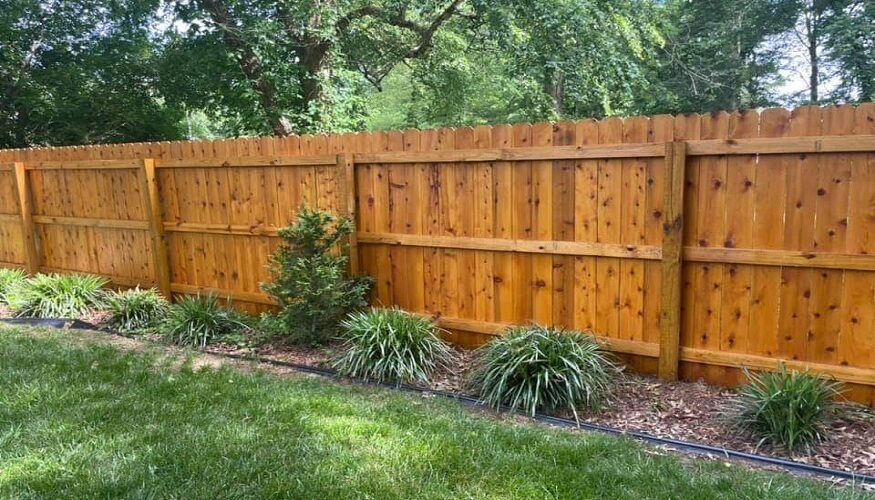4,238 Views
Selecting the perfect stain color for your fence can be a daunting task. With so many options available, it’s easy to feel overwhelmed. This guide will help you navigate the process of fence staining, ensuring you choose a color that not only protects your fence but also enhances your property’s overall aesthetic appeal.
Understanding the Importance of Fence Staining
Before diving into color selection, let’s consider why fence staining is essential:
- Protection against weather elements
- Prevention of wood rot and decay
- Enhancement of the wood’s natural beauty
- Increased longevity of the fence
Factors to Consider When Choosing a Stain Color
Several factors play a role in selecting the right stain color:
- Your home’s exterior color
- Landscape and surrounding environment
- Personal style preferences
- Neighborhood guidelines or HOA restrictions
Popular Fence Stain Colors and Their Effects
Natural and Light Tones
Light stains can:
- a) Make your yard appear larger
- b) Complement bright, colorful landscapes
- c) Create a fresh, clean look
Medium Brown Tones
Medium brown stains offer:
- A classic, timeless appearance
- Versatility in matching various home styles
- Good concealment of dirt and wear
Dark Brown and Black Tones
Darker stains can:
- Create a sense of privacy and enclosure
- Provide a modern, sophisticated look
- Highlight colorful plants and flowers in your garden
Redwood and Cedar Tones
These warm tones:
- Enhance the natural beauty of the wood grain
- Complement brick and stone exteriors
- Add a rustic charm to your outdoor space
Testing Stain Colors
Before committing to a color, it’s wise to test your options:
- Purchase small quantities of different stains
- Apply samples to inconspicuous areas of your fence
- Observe the colors at different times of day
- Consider how they look in various weather conditions
The Impact of Wood Type on Stain Color
Different wood types absorb stains differently:
- Pine: Tends to absorb stain unevenly and may require pre-stain conditioner
- Cedar: Naturally resistant to decay, takes stain well
- Redwood: Has a natural reddish hue that affects stain color
- Pressure-treated wood: May need to weather before staining
Opaque vs. Transparent Stains
The level of opacity in your stain affects the final look:
Transparent Stains
- Allow the wood grain to show through
- Offer a more natural appearance
- Provide less UV protection
Semi-Transparent Stains
- a) Offer a balance between color and wood grain visibility
- b) Provide moderate UV protection
- c) Allow for easy touch-ups
Opaque Stains
- Provide maximum color and UV protection
- Conceal imperfections in the wood
- Require more maintenance over time
Considering Your Home’s Exterior
Your fence should complement your home’s exterior:
- Match undertones (warm or cool) with your home’s color scheme
- Consider contrasting colors for visual interest
- Think about how the stain will look on your landscaping
The Role of Lighting in Color Perception
Remember that lighting affects how we perceive color:
- Natural daylight shows the truest color
- Morning light tends to be cooler in tone
- Evening light often appears warmer
- Artificial outdoor lighting can alter color appearance
Maintenance Considerations
Different stain colors have varying maintenance requirements:
- Lighter colors may show dirt more easily
- Darker colors might fade more noticeably over time
- Some colors may require more frequent reapplication
Environmental Factors
Consider your local climate when choosing a stain:
- a) High-UV areas may benefit from darker stains for better protection
- b) Humid climates might require stains with added mildew resistance
- c) Areas with extreme temperature fluctuations need flexible stains
Application Tips for Best Results
To ensure the best outcome when fence staining:
- Clean the fence thoroughly before application
- Apply stain in optimal weather conditions
- Use high-quality brushes or sprayers for even coverage
- Apply multiple thin coats rather than one thick coat
Seeking Professional Advice
If you’re still unsure:
- Consult with a local paint or hardware store specialist
- Ask for recommendations from professional fence staining services
- Look at examples of stained fences in your neighborhood
Trends in Fence Staining
While personal preference should guide your choice, current trends include:
- Gray tones for a modern, neutral look
- Two-tone staining for added visual interest
- Whitewashed effects for a beachy or farmhouse vibe
The Long-Term View
When selecting a stain color, think long-term:
- Consider how the color will age over time
- Think about potential future changes to your home’s exterior
- Factor in the ease of changing the color in the future if desired
Choosing the right stain color for your fence is a decision that impacts your home’s curb appeal and the longevity of your fence. By considering factors such as your home’s exterior, the surrounding landscape, and your personal style preferences, you can select a stain that not only protects your fence but also enhances your property’s overall aesthetic. Remember to test your chosen colors, consider the wood type, and factor in maintenance requirements. With careful consideration and these practical tips, you’ll be well-equipped to make an informed decision that you’ll be happy with for years to come.
